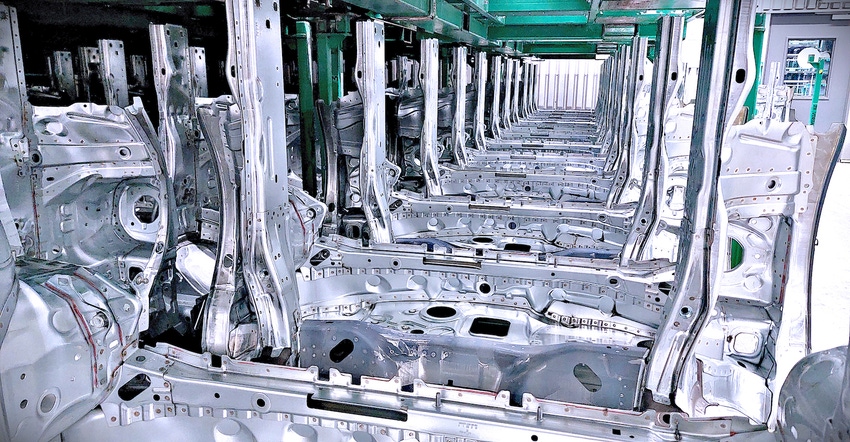Mercedes-Benz Goes All-In on Green Steel
Mercedes will use more than 200,000 tons of CO₂-reduced steel annually by 2030.

Efforts to reduce the carbon emissions from car manufacturing are multi-pronged, and a significant component of that effort is a move to green steel made using low-carbon processes. In the process of manufacturing an electric vehicle, steel accounts for as much as 20 percent of the total CO₂ emissions in its production, according to Mercedes-Benz.
As part of Mercedes’ ambitious climate protection goal “Ambition 2039” the company aims to at least halve the average CO₂ emissions per passenger car in the new vehicle fleet in 2023 compared to 2020. This accounts for CO₂ across the entire life cycle from raw material procurement, to use, and recycling. Additionally, it is the company’s goal to achieve a net carbon-neutral new car fleet by 2039.
“To make the automotive industry more sustainable, Mercedes-Benz and its partners are working to decarbonize the steel supply chain,” said Gunnar Güthenke, Head of Procurement & Supplier Quality at Mercedes-Benz Cars. “The increased availability of green steel enables us to gradually introduce CO₂ reduced steel, and in a second step, to use almost CO₂-free steel in our vehicles, significantly helping to lower our carbon footprint."
Conventional primary steel production using blast furnaces and basic oxygen furnaces generates more than two tons of CO₂ from the production of every ton of steel, on average. Direct reduction processes in an electric arc furnace (EAF) significantly reduce CO₂ emissions compared to coke-based blast furnace production.
Applying a natural-gas-based direct reduction process, carbon monoxide and hydrogen dissolve the oxygen from the iron ore. In the electric arc furnace, the direct-reduced iron is melted directly into steel together with steel scrap.
These techniques help reduce direct CO₂ emissions from the steelmaking process, while green sources of electricity to power the electric arc furnace during direct reduction manufacturing can reduce emissions to make nearly CO₂-free steel.
To achieve these goals, Mercedes has inked multiple steel supply deals that will combine to help the company achieve its goal of 200,000 tons of green steel by 2030:
Thyssenkrupp Steel: Mercedes-Benz and Thyssenkrupp Steel have signed a letter of intent for the procurement of CO₂-reduced steel using direct reduction plants in conjunction with innovative smelters. Thyssenkrupp plans to commission the first direct reduction plant in 2026 and then subsequently supply Mercedes-Benz.
Salzgitter Flachstahl GmbH: Mercedes-Benz already sources CO₂-reduced flat steel from Salzgitter Flachstahl GmbH. This is produced solely from scrap in an electric arc furnace. As a result, CO2 emissions for the respective steel grades can be reduced by more than 60 percent compared to the conventional blast furnace route. The companies have also agreed on sourcing raw steel produced with green electricity, which further increases the savings potential to more than 75 percent. Starting in 2026, Salzgitter Flachstahl also plans to supply Mercedes-Benz plants with CO₂-reduced steel produced using a combination of direct reduction processes and electric arc furnaces.
Arvedi: Mercedes-Benz also sources CO₂-reduced steel from its Italian steel partner Arvedi. To achieve this reduction, Arvedi has switched part of its production to green electricity. The partners aim to continuously increase the supply volumes of CO₂-reduced steel.
Voestalpine: In addition to decarbonizing primary steel production, steel scrap plays a crucial role in Mercedes’ “Ambition 2039” plan. Today, Voestalpine supplies the Mercedes-Benz plant in Sindelfingen with steel from its site in Linz, Austria using CO₂-neutral rail transport. Since 2021, the same train has been transporting press shop scrap from the Sindelfingen press shop back to the steelworks in Linz on its return trip, directly recycling the scrap at the original supplier. CO₂-reduced steel from an electric arc furnace (EAF) is part of the plan, through an EAF scheduled to go into operation at the Linz site as early as 2027.
SSAB: Last year, Mercedes-Benz became the first passenger car manufacturer to receive steel from SSAB's hydrogen-based direct reduction process. Based on the use of 100 percent hydrogen, the Swedish partner company reduced iron ore in its pilot plant, processed it into ultra-high-strength martensitic steel, and delivered it to the Mercedes-Benz plant in Sindelfingen. The first prototype parts were manufactured and tested for series production in the Sindelfingen technical center. This ultra-high-strength steel has the same properties as comparable steel from classic blast furnace production. The body components are cross-members for the Mercedes-Benz Modular Architecture future vehicle platform. Industrial production of nearly CO₂-free steel is scheduled to start in 2026.
H2 Green Steel: Mercedes-Benz recently sign an initial supply contract for approximately 50,000 tons of steel per year with Swedish start-up H2 Green Steel (H2GS). Mercedes-Benz took take an equity stake in H2GS in 2021. H2GS plans to produce five million tons of almost CO₂-free steel annually by 2030.
About the Author(s)
You May Also Like





